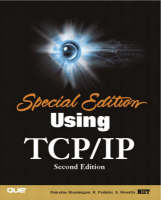
Special Edition Using TCP/IP
Que Corporation,U.S. (Verlag)
978-0-7897-2709-1 (ISBN)
- Titel ist leider vergriffen;
keine Neuauflage - Artikel merken
Special Edition Using TCP/IP, 2E is the practical guide to applications of TCP/IP, including utilities for operation, troubleshooting, and management, with insight into future applications such as Voice over IP and VPNs. It includes current TCP/IP draft standards and future work planned. Clear illustrations of practical utilities enable the reader to understand both the technology and applications together from a single source. It includes current scaling problems in the Internet like addressing and routing. Both short-term solutions and long-term solutions for these problems are discussed.
Ramadas Shanmugam brings with him a rich experience of training and instructional design. He is a computer science student and is passionate about computers and writing. Ramadas is currently working as an instructional designer at NIIT where he designs and authors books on a wide range of subjects. He has co-authored books and instructional training material on Lotus Notes, Windows NT, Mozilla Open Source Browser Programming, and Microsoft Visio. Ramadas is a Microsoft Certified Solutions Developer. Padmini.R, a graduate in computer science, has been involved in training technical courses on a wide variety of subjects thus gaining extensive exposure in training and instructional design. She has designed and created instructional training material for the Microsoft Windows 2000 Server certification exams, Microsoft Office, and Java Servlets programming. Nivedita.S, a postgraduate in biochemistry, loves to learn and believes that teaching is the best way to learn. She has designed and developed training material on topics such as StarOffice Suite, FrontPage 2000, and Visual Basic. She has also edited books on C#, Wireless LANs, and Storage Area Networks.
Introduction.
1. Introduction to Internetworking and TCP/IP.
Evolution of TCP/IP and the Internet. Internetworking. The Open Systems Interconnection Model. The TCP/IP Reference Model.
2. The Network Interface and Link Layers.
Network Interface Layer. The Link Layer. Differences Between SLIP and PPP. Addressing. Address Resolution. Reverse Address Resolution Protocol.
3. The Internet Layer Protocol.
The Internet Layer. Internet Protocol. Format of an IP Datagram. Transmission of Datagrams.
4. Internet Control Message Protocol.
Introduction to ICMP. Role of Hosts and Routers in Fault Isolation. Methods Used by a Host for Fault Isolation. Transmission of ICMP Messages.
5. Transmission Control and Data Flow.
Introduction to TCP. The Connection Process. Data Transfer Concepts.
6. Timed Data Transmission and Performance Concepts.
Timeout and Retransmission Concepts. Performance.
7. User Datagram Protocol.
Introduction to UDP. Working with UDP.
8. File Transfer and Access.
Introduction to FTP. Trivial File Transfer. Problems in the TFTP Specification. Network File Access.
9. Remote Login.
Telnet Protocol. Rlogin.
10. Messaging Protocols.
Messaging Concepts and SMTP. POP. IMAP. MIME.
11. Hypertext Transmission.
Web Fundamentals and HTTP Basics. Components of an HTTP Message. Negotiating Client/Server Capabilities. HTTP Performance. Caching.
12. Simple Network Management Protocol (SNMP).
Network Management. Components of the SNMP Architecture.
13. Domain Name System (DNS).
The Need for DNS. Advantages of Using DNS. Naming Conventions Used in DNS. Transfer of DNS Messages. Components and Steps Involved in Name Resolution.
14. Bootstrapping Protocols: BOOTP and DHCP.
Bootstrap Protocol—An Overview. BOOTP Performance. The BOOTP Message Format. Subfields in the Options Field. Dynamic Host Configuration Protocol. DHCP Performance. The DHCP Message Format. Relay Agent.
15. Subnetting and Classless Addressing.
IP Addressing Schemes. Subnetting. Supernetting.
16. IP Routing.
Routing Concepts. Error Handling.
17. Routing Mechanisms.
Introduction to Routing Mechanisms. Evolution of Network Routing Architecture. Routing Algorithms.
18. Routing on Autonomous Systems.
Autonomous System Routing Architecture. Introduction to Interior Gateway Protocols.
19. Inter-autonomous System Routing Protocol—EGP and BGP.
EGP. BGP.
20. Multicasting.
Fundamentals of Multicasting. Advantages of Multicasting. Implementation of Multicasting. Internet Group Management Protocol. Communication Between Hosts and Routers Using IGMP.
21. Security Concepts and Private Network Connection.
Virtual Private Networks. Network Address Translation.
22. IP Security.
Introduction to IP Security. The Authentication Header. Outbound and Inbound AH Field Processing. Encapsulated Security Payload. Outbound and Inbound ESP Field Processing. Security Association and Internet Key Exchange.
23. IP Over Asynchronous Transfer Mode (ATM).
Introduction to Asynchronous Transfer Mode. ATM Data Transmission Basics. IP Data Transmission Models for ATM.
24. Voice Over IP.
The Need for Voice Over IP.
25. Mobile IP.
An Introduction to IP Mobility. Agent Discovery Process. Registering Care-of Addresses. Mobile IPv6.
26. IPv6.
IPv6: An Overview. The IPv6 Message Format. IPv6 Extension Headers. IPv6 Addressing.
27. Quality of Service.
Introducing Quality of Service. Resource Reservation Protocol. Differentiated Services.
Appendix A. RFCs.
Appendix B. Local Area Networking Basics.
Local Area Networks.
Appendix C. Troubleshooting TCP/IP.
Troubleshooting Utilities.
Appendix D. HTTP Status Codes and Header Fields.
Appendix E. Programming Structures for Data Formats.
Appendix F. TCP Application Ports.
Glossary.
Index.
| Erscheint lt. Verlag | 23.5.2002 |
|---|---|
| Sprache | englisch |
| Maße | 187 x 232 mm |
| Gewicht | 844 g |
| Themenwelt | Informatik ► Netzwerke ► TCP / IP und IPv6 |
| ISBN-10 | 0-7897-2709-9 / 0789727099 |
| ISBN-13 | 978-0-7897-2709-1 / 9780789727091 |
| Zustand | Neuware |
| Haben Sie eine Frage zum Produkt? |
aus dem Bereich


